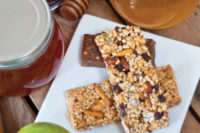Since joining the cereal division of Kerry Inc., Beloit, WI, seven months ago as a research and development technologist, I’ve learned about an array of technologies that I had limited exposure to previously. The food and grain science academic training I received at Kansas State University has proven to be a great platform on which to build. Since then, I’ve learned about natural and artificial flavors, natural flavor modulation, texture and flavor-delivery avenues via seasonings, coatings and coating systems, and sensorial perception and description. I now understand the tremendous value these specialties add to product development and finished goods.
I’ve seen the results of a dramatic reduction in the unpleasant “soy bean” flavor found in high-protein, bean-based extruded snacks due to the addition of a natural flavor modulator. Also, from the fully equipped pilot plant onsite and the visits I’ve made to a few production facilities, I’ve been able to view the manufacturing processes of many products.
Recently, you may have noticed how cereals are moving into the thriving snack market and how bite-size oat clusters are being used as novel inclusions in gourmet trail mixes and nut blends. Due to the inherent flexibility in agglomerated cereal formulations, manufacturers can adjust the texture, granulation size, appearance and flavor of ingredients, while maintaining the desired feature callouts (organic, nonGMO, high protein and fiber levels, low fat, kosher, halal, etc.).
The formulation versatility extends to the main ingredients and the forming method as well.
A preformed cluster is more regular in shape, with a much narrower size distribution than the traditional cluster. A preformed cluster with fruit and nuts comingled with oats in each poppable piece could offer new interpretation on the classic trail mix. Granola is also proving to be popular as a cost-effective staple in single-serve breakfast blends of nuts and fruit pieces.
On the job, I develop customized granola and cereal clusters, based on customer-specified product attributes. Following ideation and prototype development in an application lab, here, we use customer feedback for further revisions, if needed, before generating samples for consumer “liking tests” and retail store reviews. Upon the final product selection, we make a large-scale trial run to optimize process parameters for achieving a “gold standard” product with the ideal appearance, flavor, texture and granulation as well as for maximizing production efficiency. With product approval from the customer, the commercialization is completed for full production runs.
Raising the bar
With on-the-go consumption being a common demand, cereal bars have gained traction as a popular snack and meal-replacement option.
The versatility of extrusion technology allows us to create a wide range of crisp sizes and shapes (balls, oblong spheres, squares, irregular forms and flakes) from a variety of flours (pea, bean, rice, potato, ancient grains, corn, wheat, multigrain, soy and vegetable). Also, crisps containing soy, milk and pea protein isolates and concentrates are a convenient way to augment the protein content of a bar and cater to currently hot consumer trends. Soy flour and textured soy protein can further supplement the protein portion of a bar in a cost-effective manner.
Other possible bar ingredients currently underused include puffed grains and legumes. Both offer an interesting texture perception and the intrigue of being relatively new to the application. And legumes offer an inherently allergen-free source of protein.
Enrobing and drizzling coatings, seasonings, flavors, and fruit crystals and powders are additional avenues for creating an enticing aspect. In short, keep your eyes open for tempting new bars. I think the possibilities are practically endless
Elyse Buckley recently graduated from Kansas State University and is now a cereal research and development technologist at Kerry Ingredients and Flavors.





